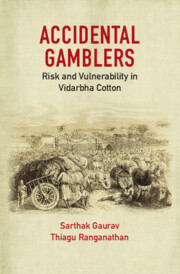6 - Risk and Vulnerability
Published online by Cambridge University Press: 18 April 2023
Summary
We have come a long way in our understanding of the changing circumstances of cotton growing in Vidarbha, and livelihood of agricultural households comprising cultivator and non-cultivator households. An inquiry into the historical roots of the region's cotton economy from a longue durée perspective revealed how constant alteration of the region's boundaries owing to political instability and sustained conflict in the precolonial era and subsequent colonial takeover in the second half of the nineteenth century transformed the region and its economy (Chapters 1 and 2).
We examined how the region witnessed an agrarian transformation that encompassed dismantling of feudal institutions such as balutedari, granting of property rights to cultivators under ryotwari in Berar, and rising demands of land revenue under the khatedari system that compelled cultivators to be dependent on usurious credit and commercialized agriculture.
We also saw how the colonial economic interests and American Civil War; historical events and processes that we characterise as accidents from the farmers’ perspective catalysed the integration of Vidarbha into the ‘Empire of Cotton’. We illustrated how the colonial efforts to convert the Bombay Presidency, Berar, and central India as an important source of raw cotton for Britain's industrial demand through crop improvement initiatives as well as investment in roads and railways that had begun before the American Civil War gathered momentum in the post-bellum period. The devastating effects of the famines in the late nineteenth century and epidemics exacted a severe toll on the region's demography along with the ecological impacts of the cotton expansion. Although the region went through phases of trade integration, the late nineteenth-century and early twentieth-century global integration established it as a vibrant cotton economy. Credit markets as well as cotton towns flourished. The region however was bereft of irrigation works unlike in other regions during the late nineteenth and early twentieth centuries.
In Chapter 3 we described our fieldwork and data collection in the villages of Vidarbha over the period 2009–2021. Having described the nature of our surveys and characteristics of the sampled households in detail, we examined the changes in cropping patterns, input use, and household incomes of cotton farmers (Chapters 4 and 5).
- Type
- Chapter
- Information
- Accidental GamblersRisk and Vulnerability in Vidarbha Cotton, pp. 315 - 372Publisher: Cambridge University PressPrint publication year: 2023

